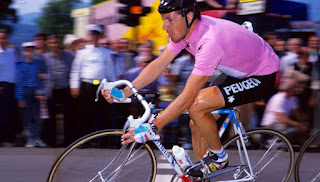Last week, I wrote of a cyclist's nightmare: a bike falling off a car carrier. Worse yet, when Dara Gannon turned around to pick up her bike, it was gone.
Another incidence of compound misery befell Nicolas Roche*, the retired Team Sky and BMC rider. He was on his way home to Monaco from London when his Easy Jet flight was cancelled. His checked bags--which included his custom-made bicycle--went through, however.
Needing to get home for a work appointment, he took another flight to Nice. When he arrived, he saw his front door--but not his bags.
 |
| Nicolas Roche's custom bike. Photo courtesy of Fifty-One. |
The bike, like other custom bikes, is built to his physique and riding style. But its design also includes graphics including his Irish road race championships, Olympic participation and Vuelta a Espana stage victories, which means it can't be mistaken for any other.
Still, eleven days later, no airline or airport employee seems to have any idea of where his bike might be. Worse, EasyJet told him that because he flew to Nice, it is now the responsibility of that city's airport to locate the bike, despite all evidence indicating that his machine is--assuming it hasn't been "found"--still in Gatwick Airport.
Roche explained that because he was trying to travel lighter than he normally does, he used different bags for his bike, kit and other items from what he'd used previously. So, in his haste, he didn't put any tracking tags on those bags, as he has done with his other bags.
Unfortunately, Roche's ordeal is hardly unique. With the return of mass air travel, understaffed airlines and airports are cancelling and re-routing flights. That has resulted in record amounts of lost luggage--including the bikes of a Canadian pro rider on his way to the Tour de France.
*--Nicolas Roche is indeed the son of Stephen Roche, the 1980s Tour de France and Giro d'Itaila winner.










